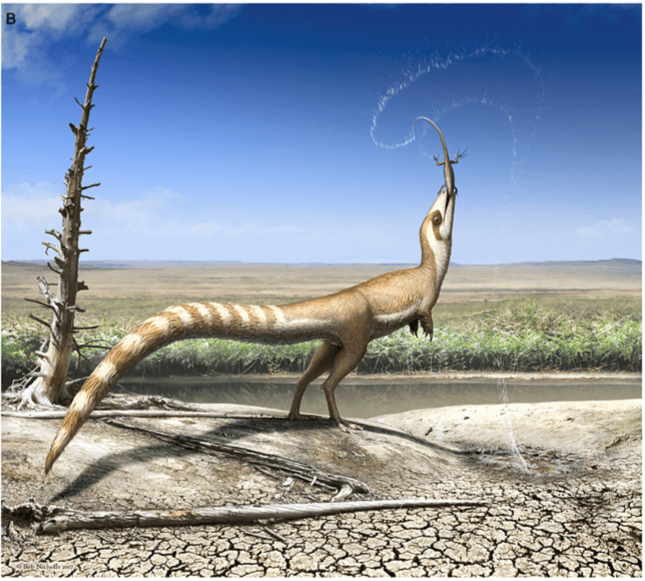Article by: Adam Manning
Edited by: J. D. Dixon and Jack Wood

Sinosauropteryx was a small theropod from the Early Cretaceous. Several exceptionally preserved specimens have been excavated from Liaoning, China. Some of these even conserved a plumage of small feathers. These fossil feathers gave a unique insight into a question that has plagued scientists for generations: ‘what colour were dinosaurs?’
To answer this question, we first need to know how the colours of modern birds are created. Melanosomes are cellular components that create and store the pigment melanin. Melanin is found in a variety of components, such as hair, skin, eyes, and, of course, feathers. The shape, orientation and abundance of these pigments determines what colour these features are. For example, iridescent feathers are created when light is refracted by a specific stacking of melanosomes. The same can be applied to many colours in many components.
In 2017, scientists realised that melanosomes were still preserved in some exquisite fossils, such as in some beautiful Sinosauropteryx feathers. They analysed the specimens of these Sinosauropteryx under a microscope and compared the melanosome pigments found in these fossilised feathers to the ones found in modern-day bird feathers, allowing them to figure out the colouration of the long-extinct dinosaur.

They found that Sinosauropteryx had orange-coloured feathers on its back and limbs, a banded tail alternating between orange and white, and a bandit mask on its face. This distinctive bandit mask may well have been for camouflage, both from prey (as it was an active carnivorous theropod) and from its own predators. The banding of the tail was likely used by the animal in display and/or communication between others of its kind, as well as a dazzling distraction to any predators. It also exhibited countershading (a lighter underside and a darker top). While poorly understood, it is suggested this feature plays little adaptive function at all. It may be that countershading helps camouflage animals, or that it has a potential role in thermoregulation or protection from UV radiation. The dark-light transition of countershading is high on the body on Sinosauropteryx, suggesting that it lived in habitats with wide open spaces. This was unexpected, as it was previously assumed that where Sinosauropteryx lived was a closed, forested habitat. Therefore, the area may have actually included a mosaic of different habitat types, only some of which Sinosauropteryx was well-adapted for.
In the end, not only did these amazing fossils begin to solve the elusive mystery regarding the colours of dinosaurs, but they also gave us a unique insight into both the habitats and the behaviours of these remarkable animals.
Image References
[1] A reconstruction of Sinosauropteryx by Bob Nicholls. Click Here.
[2] Graphical Abstract taken from Smithwick, et al, 2017.
Information References and Further Sources
[1] Galván, I., and Solano, F. (2016). ‘Bird Integumentary Melanins: Biosynthesis, Forms, Function and Evolution’, International Journal of Molecular Sciences, 17 (4), 520. DOI: https://doi.org/10.3390/ijms17040520. Accessed 8th March 2019. Click Here.
[2] Ruxton, G. D., Speed, M. P., and Kelly, D. J. (2004). ‘What, if anything, is the adaptive function of countershading?’, Animal Behaviour, 68 (3), pp. 445-451. DOI: https://doi.org/10.1016/j.anbehav.2003.12.009. Accessed 8th March 2019. Click Here.
[3] Smithwick, F. M., Nicholls, R., Cuthill, I. C., Vinther, J. (2017). ‘Countershading and Stripes in the Theropod Dinosaur Sinosauropteryx Reveal Heterogeneous Habitats in the Early Cretaceous Jehol Biota’, Current Biology, 27 (21), pp. 3337-3343.e2. DOI: https://doi.org/10.1016/j.cub.2017.09.032. Accessed 8th March 2019. Click Here.
[4] Vinther, J. (2017). ‘The True Colours of Dinosaurs’, Scientific American, 316 (3), pp. 50-57.